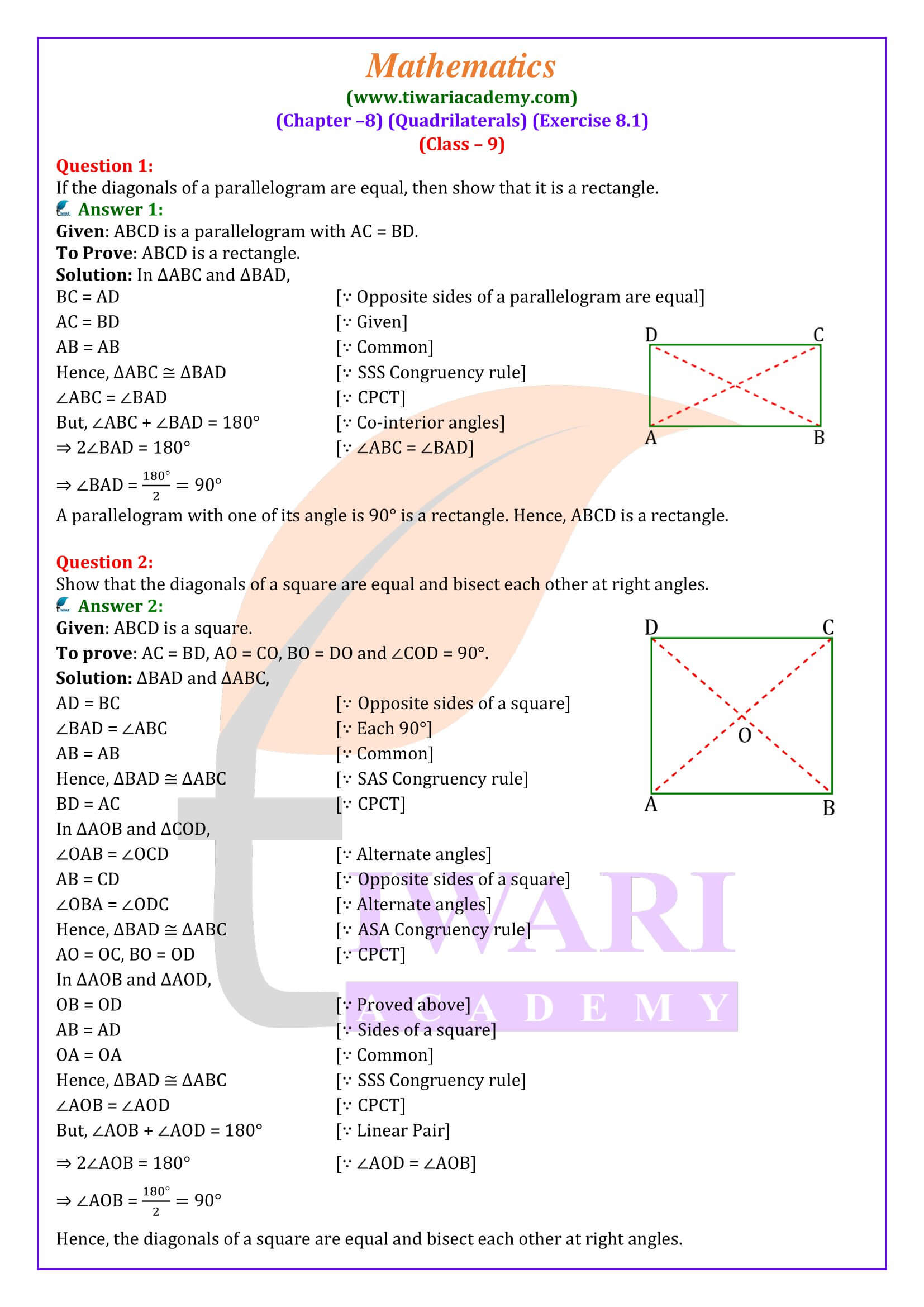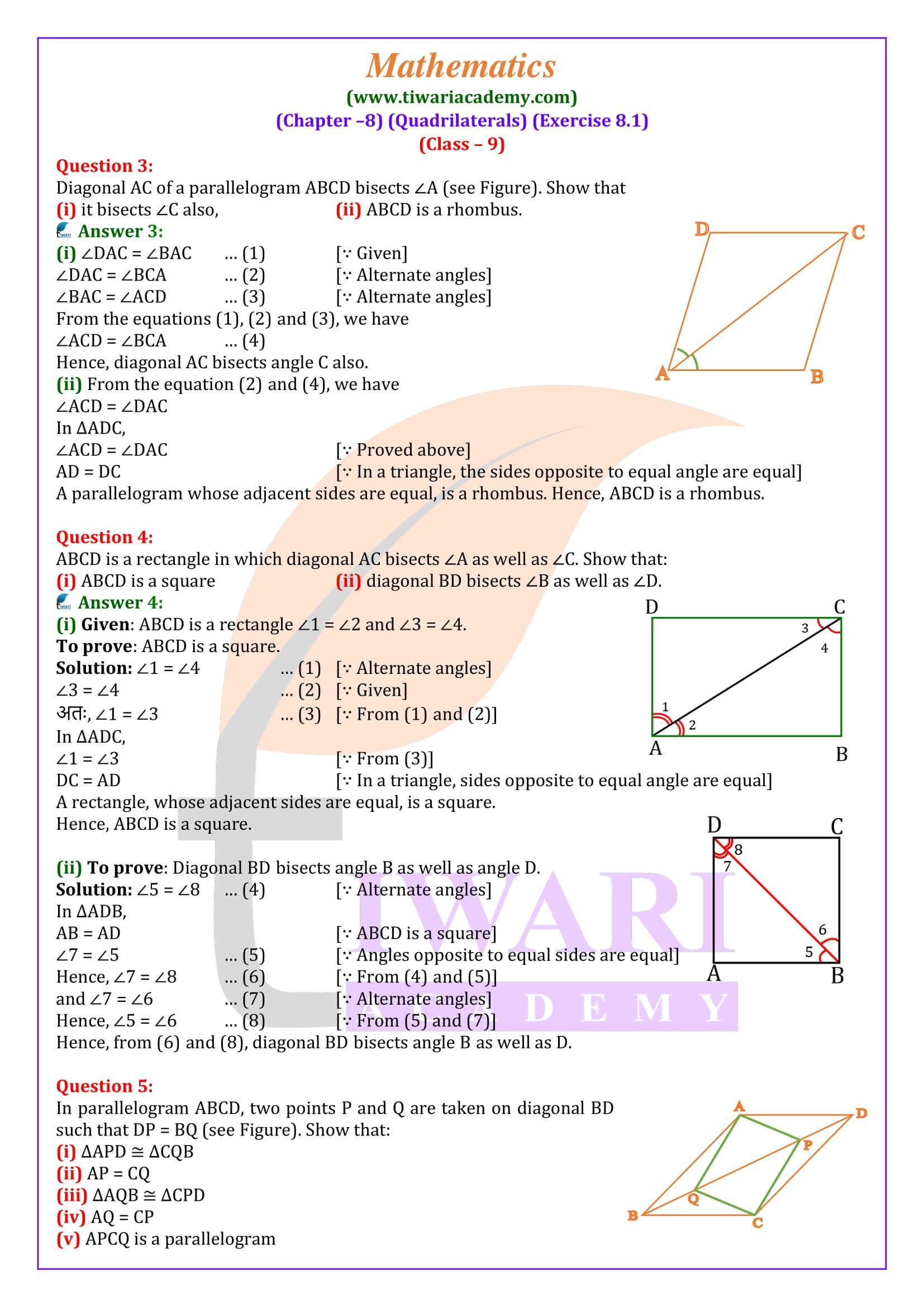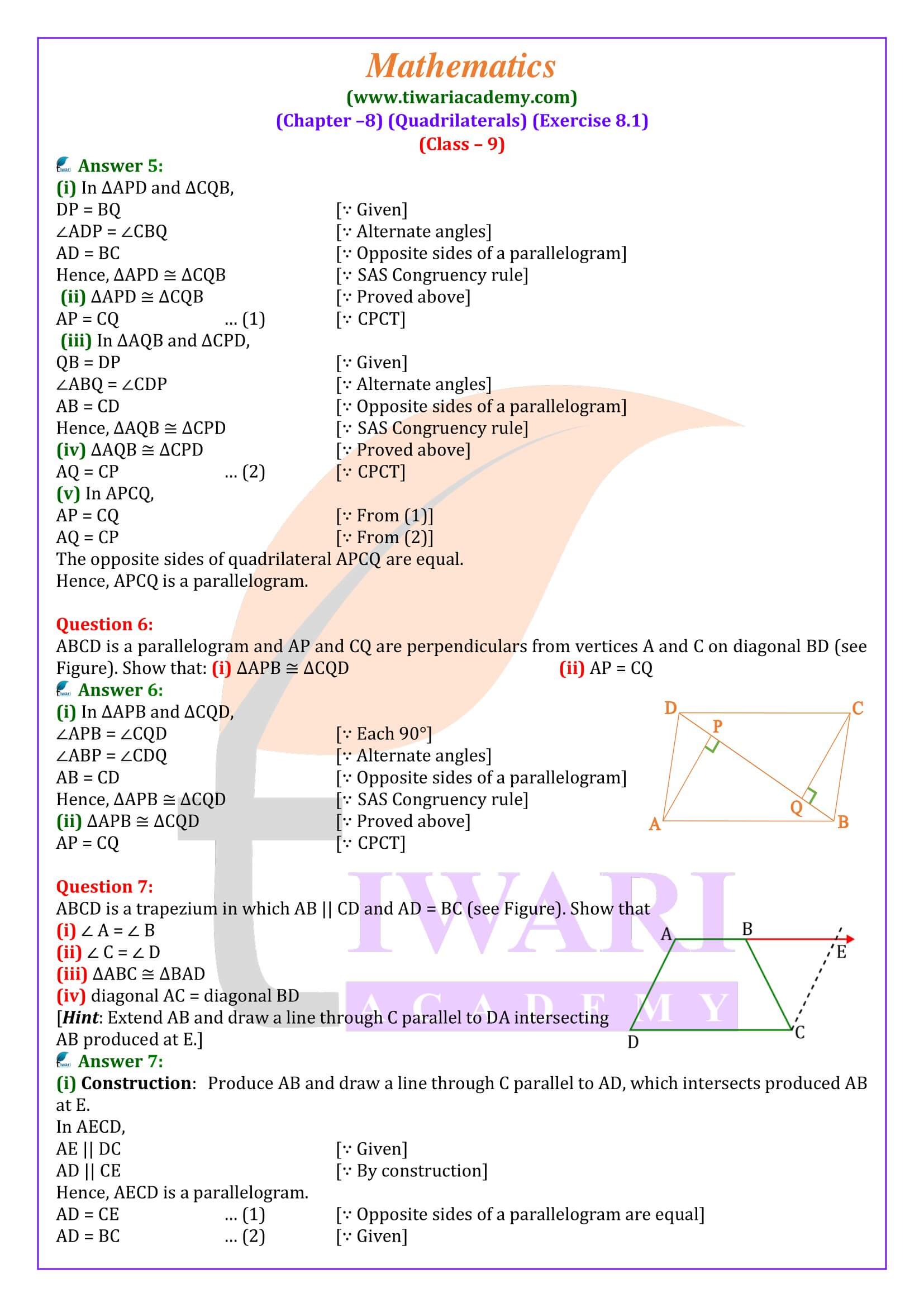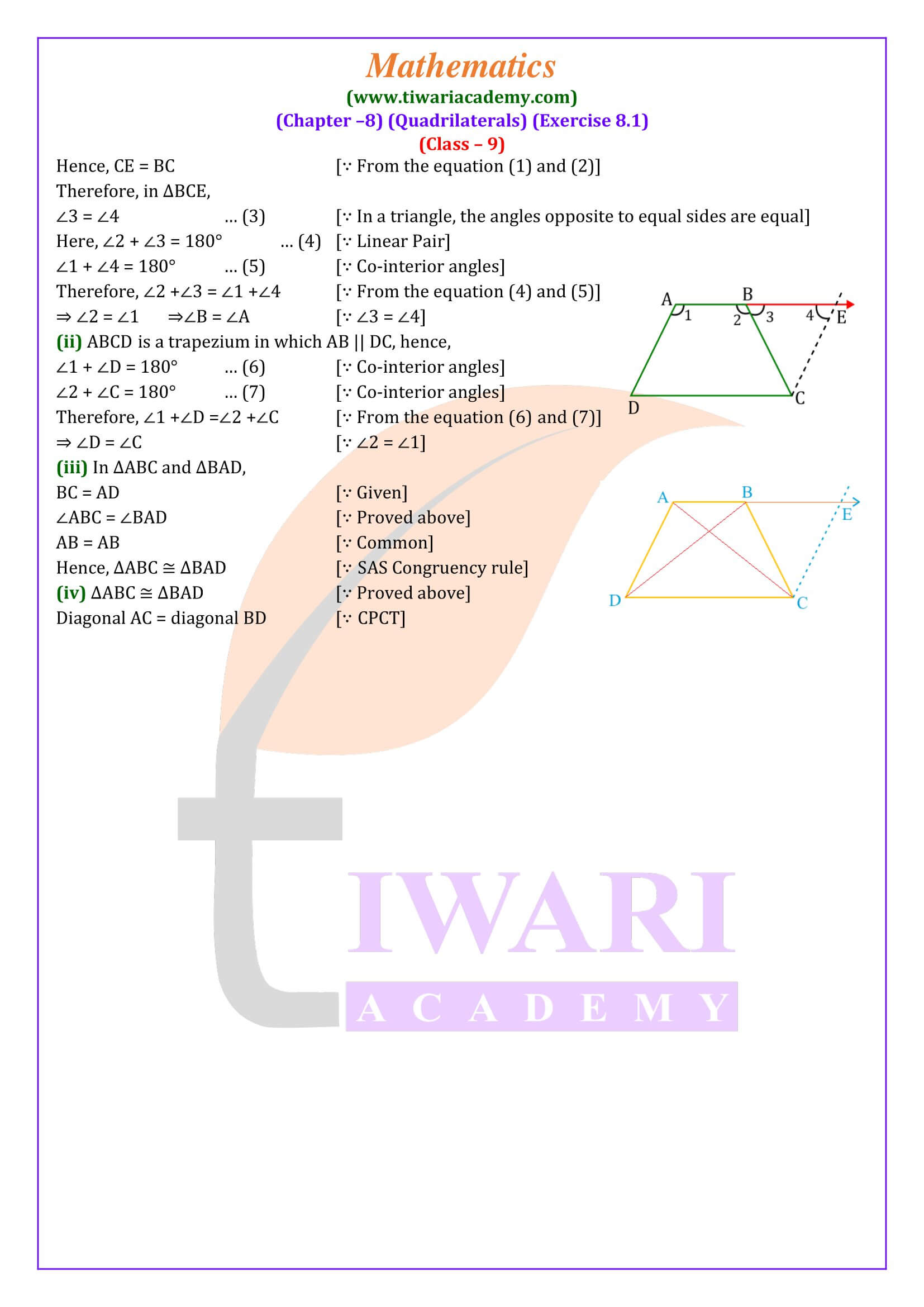CBSE NCERT Solutions for Class 9 Maths Chapter 8 Exercise 8.1 Quadrilaterals in Hindi and English Medium for CBSE Exams 2025-26. The questions and solutions of ex. 8.1 class 9 Maths are updated as per the revised syllabus following the new NCERT books for CBSE 2025-26.
NCERT Solutions for Class 9 Maths Exercise 8.1 in Hindi and English Medium
Class 9 Maths Exercise 8.1 Questions in Detail
- If the diagonals of a parallelogram are equal, then show that it is a rectangle.
- Show that the diagonals of a square are equal and bisect each other at right angles.
- Diagonal AC of a parallelogram ABCD bisects ∠A. Show that (i) it bisects ∠C also, (ii) ABCD is a rhombus.
- ABCD is a rectangle in which diagonal AC bisects ∠A as well as ∠C. Show that: (i) ABCD is a square (ii) diagonal BD bisects ∠B as well as ∠D.
- In parallelogram ABCD, two points P and Q are taken on diagonal BD such that DP = BQ. Show that: (i) Δ APD ≅ Δ CQB (ii) AP = CQ (iii) Δ AQB ≅ Δ CPD (iv) AQ = CP (v) APCQ is a parallelogram.
- ABCD is a parallelogram and AP and CQ are perpendiculars from vertices A and C on diagonal BD. Show that (i) ΔAPB ≅ ΔCQD (ii) AP = CQ.
- ABCD is a trapezium in which AB || CD and AD = BC. Show that (i) ∠A = ∠B (ii) ∠C = ∠D (iii) ΔABC ≅ ΔBAD (iv) diagonal AC = diagonal BD.
| Class: 9 | Mathematics |
| Chapter: 8 | Quadrilaterals |
| Exercise: 8.1 | NCERT Textbook Solutions |
| Content Type: | Text, PDF and Videos |
| Session: | CBSE 2025-26 |
| Medium: | Hindi and English Medium |
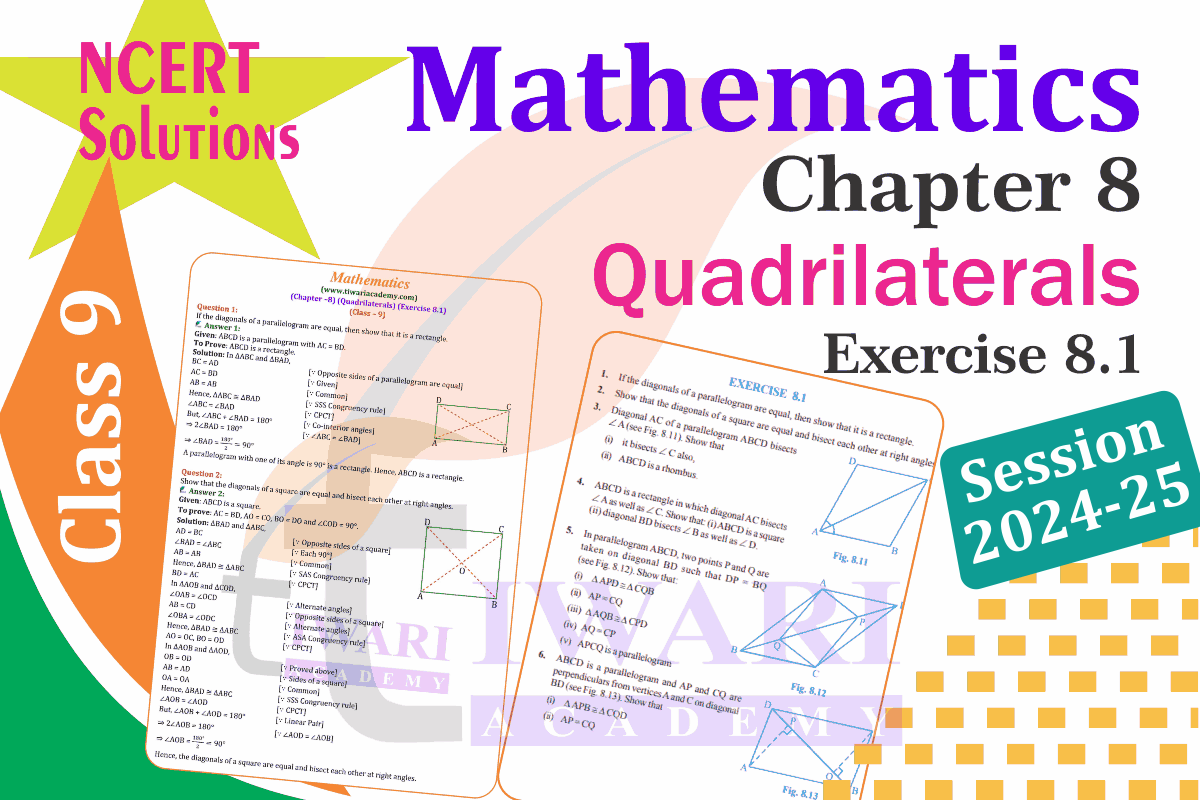
Class 9 Maths Chapter 8 Exercise 8.1 Solution in Hindi and english
Get here all the question answers with suitable solutions for ex. 8.1 of grade 9 mathematics updated for new academic session 2025-26. UP Board students can also use these solutions as UP Board Solutions for their help as there are applicable in Uttar Pradesh Board. Solutions and available in Hindi Medium as well as English Medium videos format with PDF file format free to use online or download to use offline.
Class 9 Maths Exercise 8.1 Solutions in Hindi Medium Video
What to Study in Class 9 Maths Chapter 8
We have studied many properties of a triangle so far in the mathematics chapters of classes 9 and 6, and we know that by adding three non-collinear points in pairs, the figure thus obtained is a triangle. We mark the four points and see what we get by matching them in couples in order.
Note that if all the ends meet together (on the same line), we get only one segment; if three of the four points match, we get a triangle, and if four of them If three points do not meet each other, then we get a closed figure with four. Sides. Thus a shape formed by the union of four points in a sequence is called a quadrilateral. In Mathematics Class 9, Chapter 8, we will consider only different types of quadrilaterals.
Quadrilateral in daily life
A quadrilateral has four sides, four angles, and four corners. In quadrilateral ABCD, AB, BC, CD, and DA are four arms; A, B, C, and D are four corners, and A, B, C, and D are four angles. Now join the opposite corner with C and B with D and AC. AC and BD are two diagonals of the quadrilateral ABCD. In Chapter 8 of the Ninth Mathematics, we will study more about the different quadrilaterals, properties, and parallelograms. We may wonder why we should explore quadrilaterals (or parallel quadrilaterals). If we look around us, we will find many objects with the shape of a quadrilateral: floors, walls, ceilings, your classroom windows, blackboards, each face of the duster, each page of your book, part of our study: table, and many other things.
Different Kinds of Quadrilaterals
Sometimes, the objects we look around, maybe in the shape of a rectangle. Chapter 8 of Class 9 Maths will study more about the quadrilateral, especially the parallelogram. A rectangle is also a parallel quadrilateral, and all the properties of a rectangle are valid for a rectangle. Let us now recall the property of the sum of the angles of a quadrilateral. The sum of the angles of a quadrilateral is 360. The fact can be verified by drawing a diagonal and dividing the quadrilateral into two triangles.
Some essential facts about a square, a rectangle, and a rhombus are all parallelograms.
- A square is a rectangle and also a rhombus.
- A parallelogram is a trapezium.
- A kite is not a parallel quadrilateral.
- A trapezium is not a parallel quadrilateral (since only one pair of opposite sides is in parallel, and we need both pairs to be parallel in a parallel quadrilateral).
- A rectangle or a mausoleum is not a square.
Which chapter’s revision helps the students to solve exercise 8.1 of grade 9th Maths easily?
Before solving exercise 8.1 of class 9th Maths, students should revise chapter 6 (Lines and Angles) and chapter 7 (Triangles) of class 9th Maths. These chapters help students to solve exercise 8.1 without much difficulty.
Should we do examples given just before the exercise 8.1 of 9th Maths?
Examples given just before the exercises are always important for exams and useful for clearing doubts. Always do all examples before going through the exercises.
Are there any theorems to do before exercise 8.1 of class 9th Maths?
There are eight theorems (theorem 8.1 to theorem 8.8) before exercise 8.1 of class 9th Maths. These eight theorems are:
- Theorem 8.1: A diagonal of a parallelogram divides it into two congruent triangles.
- Theorem 8.2: In a parallelogram, opposite sides are equal.
- Theorem 8.3: If each pair of opposite sides of a quadrilateral is equal, then it is a parallelogram.
- Theorem 8.4: In a parallelogram, opposite angles are equal.
- Theorem 8.5: If in a quadrilateral, each pair of opposite angles is equal, then it is a parallelogram.
- Theorem 8.6: The diagonals of a parallelogram bisect each other.
- Theorem 8.7: If the diagonals of a quadrilateral bisect each other, then it is a parallelogram.
- Theorem 8.8: A quadrilateral is a parallelogram if a pair of opposite sides is equal and parallel.
Which is the most important example from exercise 8.1 of class 9 Maths?
There is a total of six examples given just before exercise 8.1 of CBSE Class 9 Maths. Example numbers 4, 5, and 6 are considered as necessary for school tests or terminal exams.
How many days, students need to complete exercise 8.1 of class 9th Maths?
Students need a maximum of 3 days to complete exercise 8.1 of class 9th Maths if they give at least 2 hours per day to this exercise. This time also depends on student’s working speed, efficiency, capability and many other factors.
Which questions from exercise 8.1 of CBSE grade 9 math are vital for the exam?
There is a total of 12 questions given in exercise 8.1 of 9th Maths. Out of which, questions 9 and 12 are frequently asked in exams.
Which problems of exercise 8.1 of grade 9th Maths may be asked in second term of school exams?
Exercise 8.1 of class 9th Maths has 6 examples and 12 questions. All the problems of exercise 8.1 are equally important from the exam point of view. Students should practice all examples and questions of this exercise for the exams because any example and any question can come from this exercise in the school exams.
